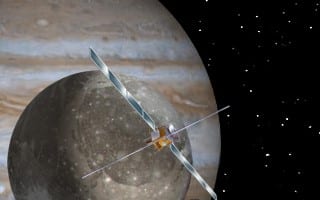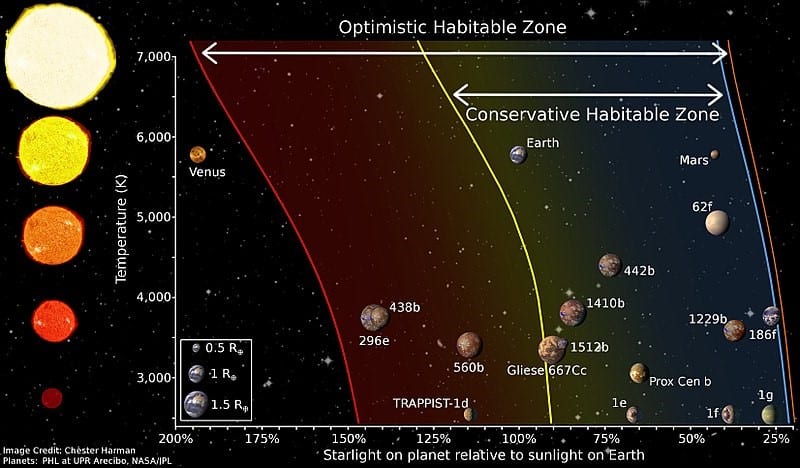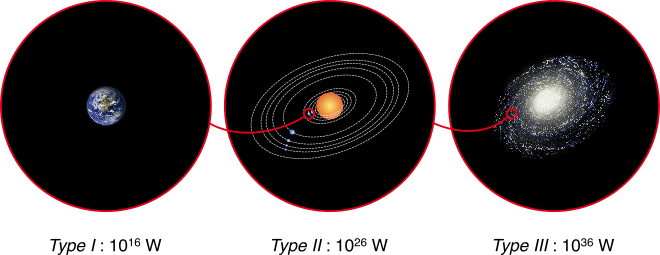As the discoveries of new planetary bodies are being made at a rapid rate around us, it inspires the question, “Are we alone in the universe?” The search for planets and development of theories on life outside of Earth is now a science in its own right, known as astrobiology.
A starting point for finding life on other planets and moons is inevitably our own solar system – because of the vast distances of interstellar space, likely to be the only celestial bodies we can send probes to in the foreseeable future. Venus, most similar in size to Earth, was once thought to be the best bet, but the combination of being closer to the Sun and having a runaway greenhouse gas environment means that temperatures proved far too high there for life as we know it. The best chances, then, seem to be Mars and some of the moons of Jupiter and Saturn.
Although significantly smaller than Earth, our closest sister planet is Mars, which it is known once had rivers and lakes on its surface. In addition, Mars is located within the habitable zone (see below) and has long been suspected to have once supported life, back when it had a much thicker atmosphere.

Source: NASA/JPL – Caltech
The Mars 2020 Rover is set to obtain samples of rock cores and soils from the Martian surface for laboratory analysis on Earth. If scientists are able to find any prehistoric traces of microorganisms among the soil, this will suggest that life once existed on Mars.
Jupiter’s moons provide the next closest possibility. JUICE stands for the Jupiter Icy Moons Explorer, an interplanetary spacecraft developed by the ESA (the European Space Agency), set to launch in 2022. JUICE’s purpose is to study the potential life-harbouring Galilean moons – Ganymede, Callisto and Europa.
These three moons are all known to contain liquid water oceans under their surfaces. Ganymede has a salt water ocean thought to be around 800 km deep, whilst Callisto and Europa have roughly 100km deep oceans. All three moons are comparable in size to our own.

Source: NASA/JPL, Mirecki
JUICE is expected to perform multiple flybys of Callisto and Europa, with the main focus on Ganymede, arriving by 2030 and entering Ganymede’s orbit by 2033. Particular areas of interest include Ganymede and Europa’s topography, crust, ocean layers and surface features.
The Jovian moons, along with Mars and Saturn’s moon Enceladus, are the front-running candidates for bodies in the solar system outside Earth that are expected to contain life. If JUICE can detect any fluctuations in the temperature of Ganymede’s oceans, this may indicate the presence of hydrothermal vents, which would further cement NASA and ESA’s suspicions for the potential for life.
Life on Earth is commonly believed to have originated from hydrothermal vents on the ocean floor. These vents pump out acidic clouds of hydrogen sulfide and carbon dioxide, which gave rise to the earliest known signs of life on earth – thermophilic archaea (primitive group of single-celled organisms) and bacteria, which rely on chemosynthesis – the synthesis of food from chemicals. Since water is key for all known lifeforms to exist, the discovery of hydrothermal vents would be a strong indicator of the possibility of the discovery of life on that planet.

When it comes to planets outside our solar system. in the mid 2010s, the discoveries of Proxima Centauri b and Kepler-186f were announced. These planets sparked huge excitement in the astrobiology community, as both are Earth-sized and orbit their respective stars within the habitable zone – the region where temperatures support liquid water on the planet’s surface, sometimes known as the ‘Goldilocks zone’ as it’s not too hot, hot too cold, but just right.
These exoplanets (planets which are found outside our solar system) are 4.2 light years and 500 light years from Earth respectively, so observations are likely to be indirect for many centuries to come. But this is just the start: there are likely to be billions of potential habitable-zones-orbiting exoplanets waiting to be discovered.
Another way we could find the presence of alien life is through searching for their impacts on the universe.
In 1960, the journal Science published a paper entitled “Search for Artificial Stellar Sources of Infra-Red Radiation” by Freeman Dyson, a English-American physicist. In his paper, Dyson formalized the concept of a Dyson sphere, inspired by Olaf Stapledon’s novel “Star Maker”.
The Dyson sphere is a thought experiment, based on the idea that any advanced alien civilization in the universe would have increasing energy demands as their population increases, much like humans. As a species advanced it would need to harvest more and more energy from its star. Eventually, the civilization’s energy consumption would demand most or all the star’s energy.
Dyson proposed that any large and intelligent alien civilization would need to create solar panel-like megastructures surrounding their star in orbit, to maximize the amount of energy harvested. With these structures orbiting around the star, the brightness of the star when seen from Earth would fluctuate depending on the orbit of these structures. He theorized that if we search for stars with significantly fluctuating brightness, such as the star KIC 8462852, this might potentially indicate the presence of an extremely intelligent and advanced alien civilization. Normal stars do not exhibit such extreme levels of light fluctuation, hence any star that does could potentially indicate the presence of a Dyson sphere. A hypothetical civilization like this would fall under the Type II civilization on the Kardashev scale.
This is a measure of a civilization’s level of advancement, ranking civilizations from 0 to III, based on their energy consumption. Humans currently fall under Type 0, as we only harvest roughly 0.2% of our energy from solar energy.

Source -Indif, Wikpedia
- Type I: harvests all its energy which reaches its planet from the star it orbits
- Type II: harvests all the energy from its parent star directly
- Type III: controls all the energy in its host galaxy.
Type III civilizations are unlikely to exist, due to the complexity required to harvest all the energy in its galaxy. One proposed method would be for the civilization to somehow harvest energy released from the supermassive black hole at the centre of their galaxy. Of course, none of this is even remotely possible for our species yet. Nevertheless, the point of these thought experiments is to show that we can possibly detect the presence of complex, intelligent alien civilizations by searching for their impact of their energy harvesting.
We started the article with a question: “Are we alone in the universe?” The answer is that we simply don’t know – yet. However, I believe that humanity’s curiosity will always overcome mankind’s obstacles, propelling us further into uncovering solutions to the many mysteries of the universe.

